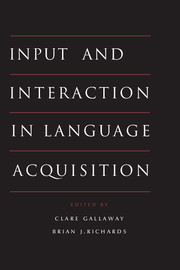Book contents
- Frontmatter
- Contents
- List of figures
- List of tables
- List of contributors
- Preface
- Introduction
- Part I General issues
- Part II Specific aspects of input and interaction
- Part III Types of language learner
- 8 Language interaction with atypical language learners
- 9 Interaction and childhood deafness
- 10 Input and interaction in second language acquisition
- Conclusion
- References
- Author index
- Subject index
8 - Language interaction with atypical language learners
Published online by Cambridge University Press: 05 June 2012
- Frontmatter
- Contents
- List of figures
- List of tables
- List of contributors
- Preface
- Introduction
- Part I General issues
- Part II Specific aspects of input and interaction
- Part III Types of language learner
- 8 Language interaction with atypical language learners
- 9 Interaction and childhood deafness
- 10 Input and interaction in second language acquisition
- Conclusion
- References
- Author index
- Subject index
Summary
Introduction
Throughout this book, the notion that environmental input and social interaction are key ingredients to language learning is discussed from different points of view. In this chapter, this notion will be examined with atypical language learners in mind. It is well known that research with impaired populations has typically lagged behind that of normal populations and language acquisition has not been an exception. Thus, the state of the art in this field is quite dependent on advances made in research with normal language learners. Nonetheless, it is thought that examining the issues involved with special populations not only provides information which has clinical relevance for the assessment and remediation of atypical language learners but also has broader implications for the nature of normally developing processes and language systems in general. This chapter is divided into seven further sections. The next section describes what is meant by atypical language learners. Then follows a review of the research on parent–child interaction with atypical language learners. This review is general, while the two continuing sections specifically address the issues of semantic contingency and directiveness. In section 6, the issue of intervention is discussed. Then follows a section presenting areas that appear under-researched with atypical language learners. Finally, the chapter ends with some concluding remarks and suggestions for future research.
- Type
- Chapter
- Information
- Input and Interaction in Language Acquisition , pp. 183 - 196Publisher: Cambridge University PressPrint publication year: 1994
- 22
- Cited by

